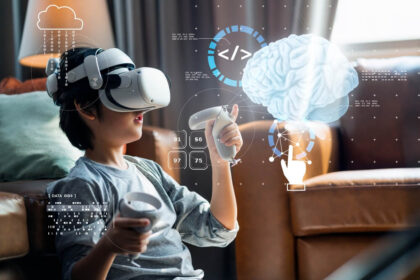
Reality technologies are gaining attention. What reality technologies are and how businesses can benefit from them?
But what is the differences between VR, AR, and MR?
Virtual Reality (VR):
Simply: virtual reality is an artificial digital environment that completely replaces the real world.
With VR, end users experience artificial sounds and sights and feel as if they’re in a digital world. Imagine opening your eyes and seeing a computer-generated world all around you; you can move in this environment and even interact with it. That’s what virtual reality is like.
Real-Life Applications of Virtual Reality:
Gaming isn’t the only field where virtual reality technology can be used.
Education
VR learning content can revolutionize education, making learning fun and more engaging. And apart from schools and universities, virtual experiences can also help businesses train their staff.
Real Estate
Unlike photos, VR is immersive, so potential buyers can take three-dimensional walkthroughs and better understand what each property has to offer before visiting in person.
Healthcare
Being immersive, virtual reality can give an in-depth look into human anatomy, helping doctors better understand their patients’ needs. VR technology also comes in handy for surgical training.
Marketing
Thanks to virtual reality, businesses can reach out to their audiences by launching immersive and engaging marketing campaigns. This is particularly important in the age of online shopping, as VR experiences help people get a feel for products without leaving their homes.
Travel
Virtual tours can help travel businesses promote destinations and attract tourists. VR is also a great way for people who have a harder time getting around to explore the world.



Augmented Reality (AR):
Augmented has already become a buzzword
A clear definition: augmented reality is the overlay of digital content on the real-world environment. Virtual objects can be in various forms: images, videos, or interactive data.
In other words, Imagine you want to buy a piece of furniture – a chair, for example. Augmented reality technology can help you check how different chairs will look in your room and pick the one that fits best.
Applications of Augmented Reality Technology
AR, in fact, proves useful in a variety of fields, from advertising to medicine
Advertising
Augmented reality helps marketers and advertisers reach out to their audiences more efficiently. Unlike conventional ads, AR ads are interactive and engaging so they not only promote sales but increase brand awareness as well.
Manufacturing
Manufacturing workers can get assistance from AR gadgets to reduce human error, save time, and increase efficiency.
Retail
Millions of people prefer making purchases on the internet. Online shopping is convenient, time-saving, and money-saving. But what if an item isn’t exactly what the buyer expected when it arrives? AR apps are a great solution to this problem, as they allow customers to virtually view or even try on products sold online.
Navigation
Augmented reality is particularly useful for navigation. Virtual objects overlapping the real world can show directions and guide people to locations.
Maintenance and Repairs
Imagine you need to repair something and you don’t know how. you can use a special augmented reality application to help you perform a repair.
Mixed Reality (MR)
Now that you know the difference between VR and AR, it’s time to take a closer look at MR. In mixed reality (sometimes called hybrid reality), virtual content is not only overlaid on the real environment (as in AR) but is anchored to and interacts with that environment.
Put simply, in mixed reality you can see virtual objects just like you can in augmented reality, but these objects can also interact with the real world. In a sense, mixed reality is a more immersive and interactive type of augmented reality.
There can be, however, a different form of mixed reality – when users see and interact with a completely virtual environment overlaid on the real world around them. If this sounds confusing, think about it this way: imagine you’re interacting with a completely digital environment but you’re still in your room. What if you trip over a physical object in your room? To avoid this problem, a headset must be able to track the real world and adjust the virtual environment accordingly. This kind of mixed reality is closer to VR than AR; in fact, some VR headsets have sensors to track the physical environment too.
Needless to say, different types of devices are required to experience these two forms of mixed reality.
Reality Technologies in brief
let’s briefly recap the distinctive of VR, AR, and MR:
• VR is a fully virtual environment
• AR is a real-world environment overlaid with virtual objects
• MR is a real-world environment plus virtual objects you can interact with




